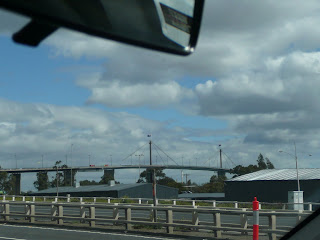Our excuse this time was that we liked it so much we should show our girls. So with two of our three sprogs in tow (number two daughter was away with her boyfriend), we set off after I finished the breakfast shift at work on Saturday.
The first hour of the outbound trip is quite boring, the free-way from Melbourne to Geelong, the only interesting thing on this stretch is the Westgate Bridge over the Yarra River.
 The Yarra isn’t a huge river but it is flat country here and the bridge has to be high to allow ships to get through into the Docklands.
The Yarra isn’t a huge river but it is flat country here and the bridge has to be high to allow ships to get through into the Docklands.Past the end of the freeway we turn off the main roads and are soon driving along typical Aussie country roads.
 Not at all typical of Oz are the dry-stone walls that line many of the roads in this region.
Not at all typical of Oz are the dry-stone walls that line many of the roads in this region.
 Land in most areas in the early days was not valuable enough to justify the labour involved in clearing stone from the paddocks and building stone walls. I suspect a few things were at play here to make the effort worthwhile: this area has very rich volcanic soils that would give a return; Victoria grew very quickly with the 1850s gold rushes which meant labour became available; and a lot of the workforce coming off the goldfields probably came from rural areas in Europe and had the skills to build walls like these.
Land in most areas in the early days was not valuable enough to justify the labour involved in clearing stone from the paddocks and building stone walls. I suspect a few things were at play here to make the effort worthwhile: this area has very rich volcanic soils that would give a return; Victoria grew very quickly with the 1850s gold rushes which meant labour became available; and a lot of the workforce coming off the goldfields probably came from rural areas in Europe and had the skills to build walls like these.We took a slightly different route this time stopping for lunch in Camperdown instead of bypassing it. In the middle of the main street is an amazing clock-tower totally out of place in the Aussie Bush. Camperdown is a small place of about 3500 people, this clock tower looks like it has been ripped out of some English town and plonked down as an after thought.
 I find this piece of architecture a little disturbing. In its own little way this monument seems as grandiose as Neuschwanstein Castle in Bavaria.
I find this piece of architecture a little disturbing. In its own little way this monument seems as grandiose as Neuschwanstein Castle in Bavaria.Much more to my taste is the bluestone post office.
 Driving west from Camperdown, and just out of town I happened to glance to the left and said “That’s got to be a crater-lake!”
Driving west from Camperdown, and just out of town I happened to glance to the left and said “That’s got to be a crater-lake!”I had mentioned vaguely to Deb a few days before that I knew there were some crater-lakes somewhere in Western Victoria, and we should try to find out where they were to visit them sometime. And there one was staring back at me.
I had seen the northern most of two massive craters just outside Camperdown.
The first is Lake Gnotuk.

The second is Lake Bullen-Merri

This image taken from Google Maps shows the sheer scale of the lakes.
 The surprising thing to me is there were no tourist oriented signs trumpeting the lakes existence that we saw in Camperdown. Surely a marketing oversight?
The surprising thing to me is there were no tourist oriented signs trumpeting the lakes existence that we saw in Camperdown. Surely a marketing oversight?From the lakes we pushed on west, pausing briefly to take a shot to demonstrate how green the western district is at the moment. This colour is very alien to most of Australia most of the time.
 Next: Wildlife at Warrnambool
Next: Wildlife at Warrnambool
3 comments:
I'm amazed how English it all looks, Al. Particularly the stone walls and the green landscape. The crater lakes are wonderful - volcanic? or meteor?
We have friends that used to live in Geelong. It is pretty amazing that no one has taken advantage of those crater lakes. That wouldn't happen here!
Hi Kathleen,
It does look very English doesn’t it? As I said in the post the stonewalls are very atypical. Southern Victoria and Tasmania can be quite green in winter/spring, but In the photo another thing that contributes to the green is that nearly all the vegetation is introduced. The windbreaks are planted from an introduced pine (probably pinus radiata), the grass is an import most likely kikuyu grass from East Africa, neither of which are Oz colours. If you click on the photo to see it full size you can see in the middle distance a belt of native eucalypts which have a more typical Oz colour, almost a khaki-green. Give it another six or eight weeks as the weather gets warmer and the whole landscape will be more like our usual dry-grass colour. (27 degrees C this weekend)
Oops, they are volcanic craters this whole patch of ground was quite volcanically active till about 30,000 ybp. Interestingly some Aboriginal dreamtime stories talk about fire mountains.
Hi Lisa,
Are your Geelong friends in the US now? It is puzzling how little these lakes are pushed. Looking at the tourist stuff from the area since I posted the little that seems to be said about the lakes is they are “great for fishing”. No “come and look at our amazing volcanoes”
Post a Comment